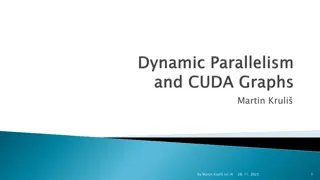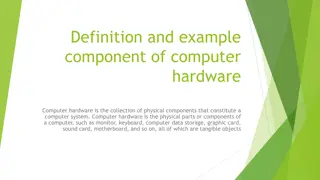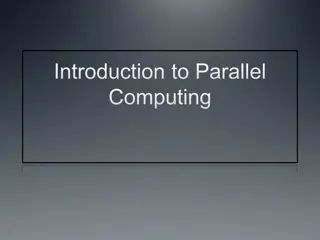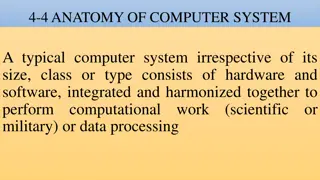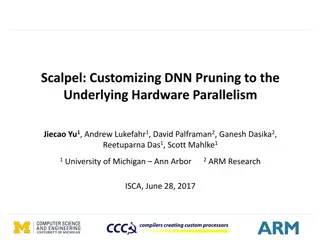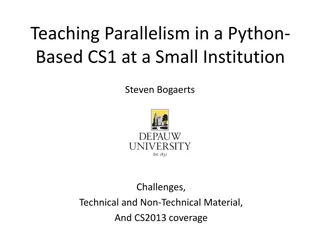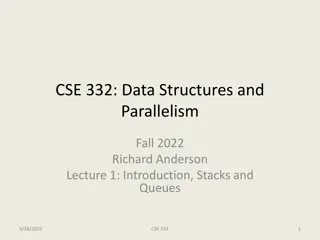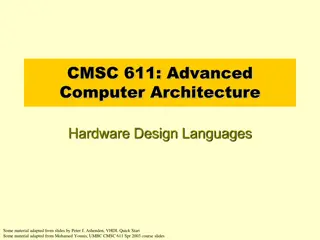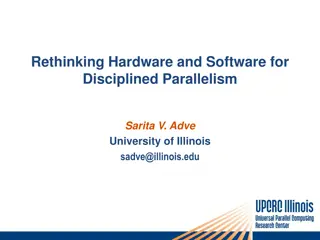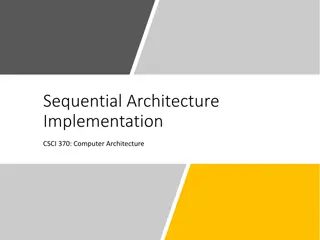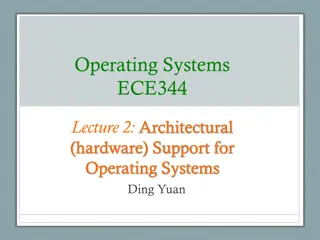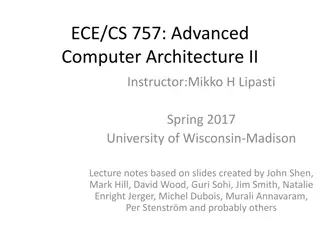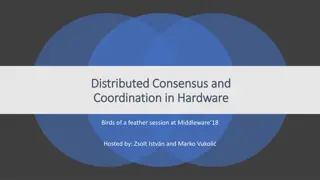
Abstract Perspective on Parallelism in Computing
Understanding and leveraging parallelism in computing systems can lead to high performance with less effort. Modern systems offer various opportunities for parallel processing, and recognizing and utilizing these can optimize the execution of tasks. The concept of embarrassing parallelism highlights instances where parallel computing opportunities are overlooked, despite being easily implementable. Exploring and maximizing parallelism in tasks like image processing can significantly enhance computational efficiency.
Download Presentation

Please find below an Image/Link to download the presentation.
The content on the website is provided AS IS for your information and personal use only. It may not be sold, licensed, or shared on other websites without obtaining consent from the author. If you encounter any issues during the download, it is possible that the publisher has removed the file from their server.
You are allowed to download the files provided on this website for personal or commercial use, subject to the condition that they are used lawfully. All files are the property of their respective owners.
The content on the website is provided AS IS for your information and personal use only. It may not be sold, licensed, or shared on other websites without obtaining consent from the author.
E N D
Presentation Transcript
IN SEARCH OF AN ABSTRACT WAY TO THINK ABOUT PARALLELISM Professor Ken Birman CS4414 Lecture 8 CORNELL CS4414 - SPRING 2023 1
IDEA MAP FOR TODAY Understanding the parallelism inherent in an application can help us achieve high performance with less effort. There is a disadvantage to this, too. If we write code knowing how that some version of the C++ compiler or the O/S will discover some opportunity for parallelism, that guarantee could erode over time. Ideally, by aligning the way we express our code or solution with the way Linux and the C++ compiler discover parallelism, we obtain a great solution This tension between what we explicitly express and what we implicitly require is universal in computing, although people are not always aware of it CORNELL CS4414 - SPRING 2023 2
MODERN SYSTEMS ARE FULL OF OPPORTUNITIES FOR PARALLISM Hardware or software prefetching into a cache File I/O overlapped with computing in the application Threads (for example, in word count, 1 to open files and many to process those files). Linux processes in a pipeline Daemon processes on a computer VMs sharing some host machine Parallel instructions in the Intel instruction set (and many others) CORNELL CS4414 - SPRING 2023 3
A FEW WAYS TO OBTAIN PARALLELISM Some of these are automatic. E.g.: if Linux notices that the file is being scanned sequentially, it will prefetch blocks. Some require special logic: To process many blocks in parallel, you launch many threads, one per block. As long as these threads don t interfere with one-another, we get an n-fold speedup. Some depend on the compiler mapping your code to parallel instructions supported by the CPU. CORNELL CS4414 - SPRING 2023 4
EMBARASSING PARALLELISM There are entire textbooks and courses on parallel algorithms But most parallel computing opportunities are totally obvious things that can easily be done simultaneously if we understand how to launch and control that pattern of execution. We call this embarrassing parallelism when the opportunity is just sitting there but we neglected to leverage it. CORNELL CS4414 - SPRING 2023 5
OPPORTUNITIES FOR PARALLELISM Consider this photo rotation: Rotate 3-D Does it have embarrassing parallism in the task? CORNELL CS4414 - SPRING 2023 6
OPPORTUNITIES FOR PARALLELISM The application has multiple threads and they are processing different blocks. The blocks themselves are arrays of pixels. We need to multiply each pixel against a small 4x4 tensor describing the rotation Application File system could be doing prefetching O/S kernel Storage device On disk, photo spans many blocks CORNELL CS4414 - SPRING 2023 7
WHAT ARE THE REQUIREMENTS FOR THE MAXIMUM DEGREE OF PARALLELISM? A task must be able to run independently from any other tasks There should be an opportunity to have many of these running The individual tasks shouldn t stall (like by waiting for I/O, or paging, or a lock) CORNELL CS4414 - SPRING 2023 8
ISSUES RAISED BY LAUNCHING THREADS: UNNOTICED SHARING Recall that we want Linux to prefetch each block. With n threads, we have n separate tasks requesting blocks. It will be important that Linux still sees these requests in order, as sequential reads. If reads jump around in the file, Linux won t notice the sequence and won t prefetch. The threads stall CORNELL CS4414 - SPRING 2023 9
ISSUES RAISED BY LAUNCHING THREADS: UNNOTICED SHARING Suppose that your application uses a standard C++ library If that library has any form of internal data sharing or dependencies, your threads might happen to call those methods simultaneously, causing interference effects. This can lead to concurrency bugs, which will be a big topic for us soon (but not in today s lecture). Preventing bugs requires locks CORNELL CS4414 - SPRING 2023 10
LOCKING CAN INVOLVE WAITING. THIS IS ONE EXAMPLE OF A THREAD STALLING We will need to learn to use locking or other forms of concurrency control (mutual exclusion). For example, in C++: std::mutex my_mutex; // Defines a form of lock { std::lock_guard my_lock(my_mutex); // Obtains the lock, may wait here this code will be safe } CORNELL CS4414 - SPRING 2023 11
LOCKING CAN INVOLVE WAITING. THIS IS ONE EXAMPLE OF A THREAD STALLING std::lock_guard works, but modern C++ has other options too. We will need to learn to use locking or other forms of concurrency control (mutual exclusion). For example, in C++: standard practice , but it involves a C++ language feature we haven t talked about yet In an upcoming lecture we will see the best std::mutex my_mutex; // Defines a form of lock { std::lock_guard my_lock(my_mutex); // Obtains the lock, may wait here this code will be safe } CORNELL CS4414 - SPRING 2023 12
LOCKING REDUCES PARALLELISM Now thread A would wait for B, or vice versa, and the protected object, such as a counter, is incremented in two separate actions But if A or B paused, we saw some delay This is like with Amdahl s law: the lock has become a bottleneck! CORNELL CS4414 - SPRING 2023 13
PARALLEL SOLUTIONS MAY ALSO BE HARDER TO CREATE DUE TO EXTRA STEPS REQUIRED Think back to our word counting programs. It avoided locks! We used 24 threads, but ended up with 24 separate sub-counts The issue was that we wanted the heap for each thread to be a RAM memory unit close to that thread So, we end up wanting each to have its own std::map to count words But rather than 24 one-by-one map-merge steps, we ended up going for a parallel merge approach CORNELL CS4414 - SPRING 2023 14
MORE COSTS OF PARALLELISM These std::map merge operations are only needed because our decision to use parallel threads resulted in us having many maps. code complexity increased CORNELL CS4414 - SPRING 2023 15
IMAGE AND TENSOR PROCESSING Images and the data objects that arise in ML are tensors: matrices with 1, 2 or perhaps many dimensions. Operations like adjusting the colors on an image, adding or transposing a matrix, are embarrassingly parallel. Even matrix multiply has a mix of parallel and sequential steps. This is why hardware vendors created GPUs. CORNELL CS4414 - SPRING 2023 16
CONCEPT: SISD VERSUS SIMD X = Y*3; A normal CPU is single instruction, single data An instruction like movq moves a single quad-sized integer to a register, or from a register to memory. An instruction like addq does an add operation on a single register So: one instruction, one data item CORNELL CS4414 - SPRING 2023 17
Rotate 3-D CONCEPT SISD VERSUS SIMD A SIMD instruction is a single instruction, but it operates on a vector or matrix all as a single operation. For example: apply a 3-D rotation to my entire photo in one operation In effect, Intel used some space on the NUMA chip to create a kind of processor that can operate on multiple data items in a single clock step. One instruction, multiple data objects: SIMD CORNELL CS4414 - SPRING 2023 18
Rotate 3-D SIDE REMARK In fact, rotating a photo takes more than one machine instruction. It actually involves a matrix multiplication: the photo is a kind of matrix (of pixels), and there is a matrix-multiplication we can perform that will do the entire rotation. So a single matrix multiplication, but it takes a few instructions in machine code, per pixel. SIMD could do each instruction on many pixels at the same time. CORNELL CS4414 - SPRING 2023 19
SIMD LIMITATIONS A SIMD system always has some limited number of CPUs for these parallel operations. Moreover, the computer memory has a limited number of parallel data paths for these CPUs to load and store data As a result, there will be some limit to how many data items the operation can act on in that single step! CORNELL CS4414 - SPRING 2023 20
INTEL VECTORIZATION COMPARED WITH GPU A vectorized computation on an Intel machine is limited to a total object size of 64 bytes. Intel allows you some flexibility about the data in this vector. It could be 8 longs, 16 int-32 s, 64 bytes, etc. In contrast, the NVIDIA Tesla T4 GPU we talked about in lecture 4 has thousands of CPUs that can talk, simultaneously, to the special built-in GPU memory. A Tesla SIMD can access a far larger vector or matrix in a single machine operation. CORNELL CS4414 - SPRING 2023 21
CS4414 IS ABOUT PROGRAMMING A NUMA MACHINE, NOT A GPU So, we won t discuss the GPU programming case. But it is interesting to realize that normal C++ can benefit from Intel s vectorized instructions, if your machine has that capability! To do this we need a C++ compiler with vectorization support and must write our code in a careful way, to expose parallelism CORNELL CS4414 - SPRING 2023 22
SPECIAL C++ COMPILER? There are two major C++ compilers: gcc from GNU and clang, created by LLVM (an industry consortium) But many companies have experimental extended compilers. The Intel one is based on Clang but has extra features. All are moving targets . For example, C++ has been evolving (C++ 11, 17, 20 .) each compiler tracks those (with delays). CORNELL CS4414 - SPRING 2023 23
THE INTEL VECTORIZATION INSTRUCTIONS When the MMX extensions to the Intel x86 instructions were released in 1996, Intel also released compiler optimization software to discover vectorizable code patterns and leverage these SIMD instructions where feasible. The optimizations are only available if the target computer is an Intel chip that supports these SIMD instructions. CORNELL CS4414 - SPRING 2023 24
INITIALLY, C++ DID NOT SUPPORT MMX It took several years before other C++ compilers adopted the MMX extensions and incorporated the associated logic. Today, C++ will search for vectorization opportunities if you ask for it, via -ftree-vectorize or O3 flags to the C++ command line. so, many programs have vectorizable code that doesn t exploit vector-parallel opportunities even on a computer than has MMX CORNELL CS4414 - SPRING 2023 25
ALSO, INTEL IS NOT THE ONLY CPU DESIGNER AMD is another major player in the CPU design space. They have their own vector-parallel design, and the instructions are different from the Intel ones (but similar in overall approach). ARM is an open-source CPU design. It aims at mobile phones and similar systems, and has all sorts of specializations for tasks such as video replay and image or video compression. CORNELL CS4414 - SPRING 2023 26
MODERN C++ SUPPORT FOR SIMD Requires -ftree-vectorize or O3 You must write your code in a vectorizable manner: simple for loops that access the whole vector (the loop condition can only have a simple condition based on vector length), body of the loop must map to the SIMD instructions. CORNELL CS4414 - SPRING 2023 27
GNU C++ EXAMPLES THAT WOULD PARALLELIZE AUTOMATICALLY This simple addition can be done in parallel. Example 1: int a[256], b[256], c[256]; foo () { int i; The compiler will eliminate the loop if a single operation suffices. Otherwise it will generate one instruction per chunk for (i=0; i<256; i++){ a[i] = b[i] + c[i]; } } https://gcc.gnu.org/projects/tree-ssa/vectorization.html CORNELL CS4414 - SPRING 2023 28
GNU C++ EXAMPLES THAT WOULD PARALLELIZE AUTOMATICALLY Example 2: int a[256], b[256], c[256]; foo (int n, int x) { int i; /* feature: support for unknown loop bound */ /* feature: support for loop invariants */ for (i=0; i<n; i++) b[i] = x; } /* feature: general loop exit condition */ /* feature: support for bitwise operations */ while (n- -){ a[i] = b[i]&c[i]; i++; } } Here we see more difficult cases The compiler can t predict the possible values n could have, making this code hard to chunk https://gcc.gnu.org/projects/tree-ssa/vectorization.html CORNELL CS4414 - SPRING 2023 29
GNU C++ EXAMPLES THAT WOULD PARALLELIZE AUTOMATICALLY Example 8: int a[M][N]; foo (int x) { int i,j; Parallelizing a 2-d matrix seems easy but in fact data layout matters. /* feature: support for multidimensional arrays */ for (i=0; i<M; i++) { for (j=0; j<N; j++) { a[i][j] = x; } } } To successfully handle such cases, the dimensions must be constants known at compile time! https://gcc.gnu.org/projects/tree-ssa/vectorization.html CORNELL CS4414 - SPRING 2023 30
GNU C++ EXAMPLES THAT WOULD PARALLELIZE AUTOMATICALLY Example 9: unsigned int ub[N], uc[N]; foo () { int i; This sum over differences is quite a tricky operation to parallelize! /* feature: support summation reduction. note: in case of floats use -funsafe-math-optimizations */ unsigned int diff = 0; for (i = 0; i < N; i++) { udiff += (ub[i] - uc[i]); } C++ uses a temporary object, generates the diff, then sums over the temporary array https://gcc.gnu.org/projects/tree-ssa/vectorization.html CORNELL CS4414 - SPRING 2023 31
SUMMARY: THINGS YOU CAN DO Apply a basic mathematical operation to each element of a vector. Perform element-by-element operations on two vectors of the same size and layout Apply a very limited set of conditional operations on an item by item basis CORNELL CS4414 - SPRING 2023 32
ADVICE FROM INTEL Think hard about the layout of data in memory Vector hardware only reaches its peak performance for carefully aligned data (for example, on 16-byte boundaries). Data must also be densely packed: instead of an array of structures or objects, they suggest that you build objects that contain arrays of data, even if this forces changes to your software design. Write vectorization code in simple basic blocks that the compiler can easily identify. Straight-line code is best. inline any functions called on the right-hand of an = sign CORNELL CS4414 - SPRING 2023 33
WITHIN THAT CODE On the right hand slide of expressions, limit yourself to accessing arrays and simple invariant expressions that can be computed once, at the top of the code block, then reused. Avoid global variables: the compiler may be unable to prove to itself that the values don t change, and this can prevent it from exploring many kinds of vectorization opportunities. CORNELL CS4414 - SPRING 2023 34
LEFT HAND SIDE When doing indexed data access, try to have the left hand side and right hand side match up : vectors of equal size, etc. Build for loops with a single index variable, and use that variable as the array index don t have other counters that are also used. SIMD code can access a register holding the for-loop index, but might not be able to load other kinds of variables like counters CORNELL CS4414 - SPRING 2023 35
THINGS TO AVOID No non-inlined function calls in these vectorizable loops, other than to basic mathematical functions provided in the Intel library No non-vectorizable inner code blocks (these disable vectorizing the outer code block) No data dependent end-of-loop conditions: These often make the whole loop non-vectorizable CORNELL CS4414 - SPRING 2023 36
POTENTIAL SPEEDUP? With Intel MMX SIMD instructions, you get a maximum speedup of about 128x for operations on bit vectors. More typical are speedups of 16x to 64x for small integers. Future processors are likely to double this every few years CORNELL CS4414 - SPRING 2023 37
FLOATING POINT Given this form of vectorized integer support, there has been a lot of attention to whether floating point can somehow be mapped to integer vectors. In certain situations this is possible: it works best if the entire vector can be represented using a single exponent, so that we can have a vector of values that share this same exponent, and then can interpret the vector as limited-precision floating point. CORNELL CS4414 - SPRING 2023 38
C++ VECTORIZATION FOR FLOATS There is a whole ten-page discussion of this in the compiler reference materials! With care, you can obtain automatically vectorizable code for floats, but the rules are quite complicated. However, GPU programming would be even harder! CORNELL CS4414 - SPRING 2023 39
COULD THIS SOLVE OUR PHOTO ROTATION? We can think of a photo as a flat 3-D object. Each pixel is a square. A 3-D rotation is a form of matrix multiplication. CORNELL CS4414 - SPRING 2023 40
TWO FLOATING POINT OPTIONS We could construe our pixels as floating point numbers. But we could also replace a floating point number by a rational number. For example: 22/7. So, x* (x*22)/7. CORNELL CS4414 - SPRING 2023 41
RATIONAL ARITHMETIC LETS US LEVERAGE THE INTEL VECTOR HARDWARE The Intel vector instructions only work for integers. But they are fast, and parallel, and by converting rational numbers to integers, we can get fairly good results. Often this is adequate! CORNELL CS4414 - SPRING 2023 42
THIS IS WIDELY USED IN MACHINE LEARNING! We noted that many ML algorithms are very power-hungry Researchers have shown that often they are computing with far more precision than required and that reduced-precision versions work just as well, yet can leverage these vector-parallel SIMD instructions. These are available in reduced-precision ML libraries and graphics libraries today. CORNELL CS4414 - SPRING 2023 43
GPU VERSUS SIMD Why not just ship the parallel job to the GPU? GPUs are costly, and consume a lot of power. A standard processor with SIMD support that can do an adequate job on the same task will be cheaper and less power-hungry. Even if you do have a GPU, using it has overheads: The system must move the data into the GPU. Like a calculator where you type in the data. Then it asks the GPU to perform some operation. Press the button Then must read the results out. CORNELL CS4414 - SPRING 2023 44
An earlier new age NEW-AGE OPTIONS These include TPU accelerators: tensor processing units FPGA: A programmable circuit, which can be connected to other circuits to build huge ultra-fast vision and speech interpreting hardware, or blazingly fast logic for ML. RDMA: Turns a rack of computers or a data center into a big NUMA machine. Every machine can see the memory of every other machine CORNELL CS4414 - SPRING 2023 45
STEPPING BACK WE FIND CONCEPTUAL ABSTRACTION PATTERNS. When you look at a computer, like a desktop or a laptop, what do you see? Some people just see a box with a display that has the usual applications: Word, Zoom, PowerPoint Advanced systems programmers see a complex machine, but they think of it in terms of conceptual building blocks. CORNELL CS4414 - SPRING 2023 46
SPEED VERSUS PORTABILITY One risk with this form of abstract reasoning is that code might not easily be portable. We are learning about SIMD opportunities because most modern computers have SIMD instruction sets (Intel, AMD, etc). A feature available on just one type of computer can result in a style of code that has poor performance on other machines. CORNELL CS4414 - SPRING 2023 47
APPLICATIONS CAN HAVE BUILT-IN CHECKS If you do create an application that deliberately leverages hardware such as a particular kind of vectorization, it makes sense to have unit tests that benchmark the program on each distinct computer. The program can then warn if used on an incompatible platform: This program has not been optimized for your device, and may perform poorly . CORNELL CS4414 - SPRING 2023 48
SUMMARY Understanding the computer architecture, behavior of the operating system, data object formats and C++ compiler enables us to squeeze surprising speedups from our system! Because SIMD instructions have become common, it is worth knowing about them. When you are able to leverage them, you gain speed and reduce power consumption. CORNELL CS4414 - SPRING 2023 49


